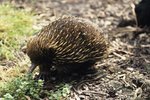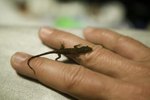
The number of offspring a species produces is finely tuned to optimize its chances for survival. For some, the best strategy is to produce a great number of relatively small young; though predators will consume many of them, the odds are good that at least a few offspring will survive to maturity. Often, the geography and resources available to the females influence the number of offspring that the species produces as well.
Reproductive Strategy
Most organisms exhibit reproductive strategies that broadly fall into one of the two categories; those which produce a large number of young, termed r-selected species, and K-selected species that produce a few well-developed offspring. For example, humans -- who have no more than one offspring per year -- are said to be K-selected, while mice -- r-selected organisms -- may produce dozens of young in a year. Another factor involved in determining the litter size of an organism is the optimal size of its offspring. As the space inside the mother's body available for the developing offspring is finite, litter size and offspring size are often inversely proportionate.
It's Easier Laying Eggs
While the term “litter” typically refers to a group of live born young, live-bearing species do not have a monopoly on large reproductive effort. Many animals deposit very large numbers of eggs, especially fish, frogs and invertebrates. As egg layers usually deposit eggs relatively early in the developmental process -- as opposed to live young, whose development is usually advanced by the time of birth -- egg-laying females usually can carry more offspring in their body cavity. Because they engage in external fertilization and they release the eggs before they have started developing, many fish secrete an incredible number of eggs. Female ocean sunfish (Mola mola) sometimes release up to 300 million eggs into the water, though only a small percentage of the total are fertilized.
Particularly Prolific
For mammals, the number of nipples roughly corresponds with their maximum litter size, though generally, clutches average about half this number. Tailless tenrecs (Tenrec ecaudatus) have as many as 29 nipples and have produced litters of 32 offspring in the wild. Puff Adders (Bitis arietans) are extremely prolific -- one female gave birth to 156 young in one litter. Large nile monitors (Varanus niloticus) thrive in the face of numerous competing species by depositing up to 60 eggs per clutch. The record for fecundity, or the number of animals produced by a female, probably belongs to a eusocial insect, such as an ant or bee. Some entomologists think that African driver ants (Dorylus wilverthi) are the most prolific species: The queens deposit 3 million to 4 million eggs every 25 days or so.
Individual and Geographic Variation
Sometimes, an individual mother will give birth to a much larger or smaller number of babies than is typical for her species. This often correlates with the amount of food the mother has been able to accumulate prior to breeding. Some species exhibit varying fecundity among populations living in different locations. Egg-laying species demonstrate this phenomenon well: On average, birds living near the equator deposit fewer eggs than birds living closer to the poles.
References
- New Scientist: Zoologger: The World's Most Fecund Vertebrate
- Stanford University: Variation in Clutch Sizes
- Philosophical Transactions of the Biological Society: Beyond Size–Number Trade-Offs: Clutch Size as a Maternal Effect
- Science Daily: Why Some Bird Species Lay Only One Egg
- World Association of Zoos and Aquariums: Nile Monitor
- University of Florida: Book of Insect Records: Chapter 18: Highest Lifetime Fecundity
- Focus Science and Technology: Which Mammal Produces the Largest Litter of Babies?
- Snakes: The Evolution of Mystery in Nature; Harry W. Greene
- University of Miami: R and K Selection
Photo Credits
-
John Foxx/Stockbyte/Getty Images




